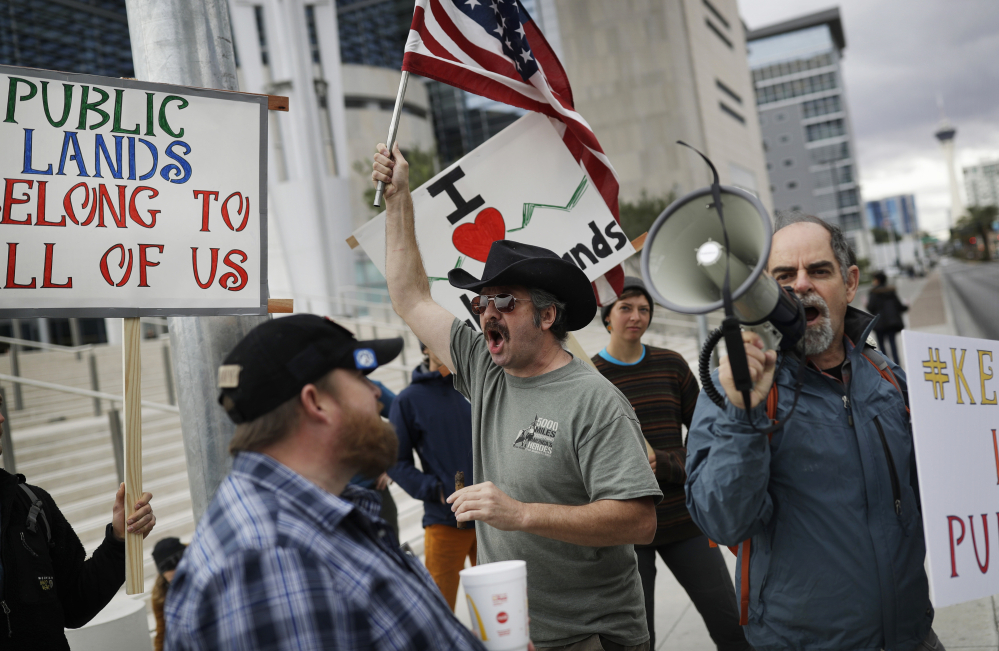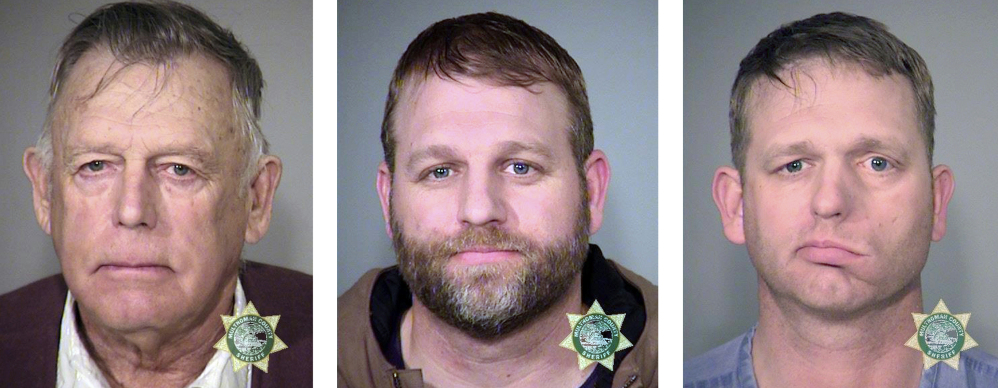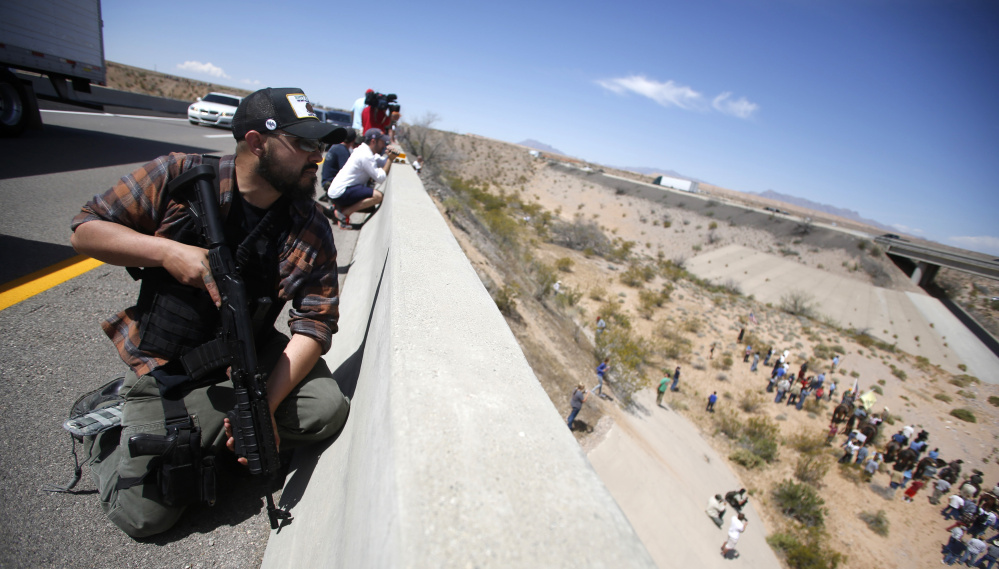LAS VEGAS — More than three years after Nevada rancher Cliven Bundy and hundreds of militiamen faced off with federal law enforcement officers who had seized his cattle, the 71-year-old’s battle moves to the courtroom.
The Bundy family has been at the center of a long-running dispute with federal authorities over the use of public lands for cattle grazing, and Bundy gathered with militias from around the country in April 2014 to challenge the federal government. Wearing camouflage and flak jackets and carrying semiautomatic rifles, they gathered in a dusty, washed-out canyon beneath the overpasses of Interstate 15, where two dozen federal officers had corralled Bundy’s cows after he refused to pay years of grazing fees.
The standoff included militiamen on horseback carrying American flags and snipers positioned on freeway overpasses, their sights trained on the federal officers below.
No one was hurt and no shots were fired.
But Bundy and two of his sons – Ryan and Ammon – are facing federal trial here on charges of conspiracy to commit an offense against the United States, conspiracy to impede and injure a federal officer, and extortion, among other allegations that, if they result in convictions, could lead to lifetime prison sentences. Prosecutors argued in opening statements this week that the standoff was an attack on the government; lawyers representing the Bundys say the gathering was an exercise of the family’s right to protest.
U.S. attorney Steven Myhre argued before a jury that the Bundys gathered supporters by putting out exaggerated propaganda that the family was “under attack,” that the government had snipers pointed at them, that the situation at the desert ranch along the Arizona border had “the potential to be the next Waco or Ruby Ridge.” That message spoke to militias nationwide. “This was not a protest,” Myhre said. “A protest is when you attempt to send a message and do it peacefully.”
Bundy’s attorney, Bret Whipple, argued that the family and protesters were peaceful. As he gave his opening statement, he played several videos showing federal officers throwing a Bundy woman to the ground and deploying tasers and working dogs against Ammon Bundy. The protesters, Whipple said, caused the federal authorities to back off and to release the cattle, ultimately defusing the situation.
Whipple said that the events were the culmination of years of Bundy trying to draw attention to what he saw as overreach.
“His family was being attacked. His family was being abused,” Whipple said. “The American spirit believes you can stand up and speak your mind anytime.”
The three Bundy men have been behind bars since early 2016, held because they were believed to be flight risks and potential dangers to the community.
Cliven Bundy was arrested at Portland International Airport in Oregon, where he had flown to join his sons, who at the time were engaging in a standoff of their own at the Malheur National Wildlife Refuge.
When prosecutors pushed to delay the trial further on Tuesday, Chief Judge Gloria Navarro asked Cliven Bundy how he wanted to proceed. He responded: “Let’s get it done.” A jury of nine men and eight women will hear the case, which is expected to last months.
Bundy’s troubles began in the early 1990s, Myhre told the jury in his opening statements, when the man stopped paying to graze his cattle on federal public lands managed by the Bureau of Land Management.
The Bundy Ranch is a 160-acre plot near the town of Bunkerville, south of Las Vegas. It’s a remote swath of dusty, rocky red desert, a place where water and vegetation is hard to come by. Like many ranchers, Bundy also leased allotments of the federal lands that surround his property to graze his cattle – 587,000 acres of land that belongs to everyone, Myhre said. Until 1993, Bundy paid his grazing fees.
“After that,” Myhre told the jury, “he refused to do so.”
The rancher squabbled with federal officials – in and out of court – over his right to graze his herd on that land for two decades, continually saying he would “do whatever it takes” to protect his cattle.
In late 2013, court orders in hand, federal officials told Bundy to move his herd off the public lands. “Ultimately the BLM came to enforce the court orders,” Myhre said, telling Bundy: “‘If you do not remove these cattle, the BLM will remove them for you.'”
That’s when Bundy put out a call for reinforcements, reaching out to militias around the country and “people who were willing to take up arms and defeat tyranny,” Myhre said.
Last year, the Bundy sons, during a trial for the Malheur standoff, alleged that the armed occupation of the bird refuge was a protest of federal land ownership. Ammon and Ryan Bundy were acquitted of all charges there in November 2016, and Tuesday’s trial in Las Vegas opened with a similar sentiment: that the family gathering armed people to Bundy’s cows back was a protest of government overreach.
On Tuesday morning, for the first time in more than 600 days, one Bundy came to his trial through the front doors of the courthouse. Just before 8 a.m., Ryan Bundy – who had been released to a halfway house on Monday evening – pulled up to the federal courthouse on a palm tree-lined street in a white stretch limousine. He strode through the courthouse doors in a three-piece suit and a white cowboy hat.
After the first day of the trial, Ryan Bundy – who is acting as his own attorney – was surrounded by reporters as he walked from the courthouse, holding his wife’s hand. He at first indicated that he didn’t want to talk, rushing down a sidewalk. But he slowed his pace to say one thing:
“The government wants to take that statement ‘whatever it takes’ as a threat,” he said. On Wednesday morning, Ryan Bundy faced the jury and addressed that statement again, saying it wasn’t a threat at all.
“It is a statement of determination …. it is a commitment to freedom,” he said. “Being right here before you today is part of ‘whatever it takes.'”
Where both Myhre and Whipple relied on computer presentations to guide jurors through their opening statements, Ryan Bundy presented his against the backdrop of a photograph of his family: his wife, six daughters and two sons. Bundy was shown holding his youngest child, looking out from under the brim of a cowboy hat.
Bundy asked jurors to take themselves to the family’s ranch, talking about his childhood chasing frogs and swimming in river streams, “to see the beautiful sunrises and moonrises,” to feel their bare feet against the sandy desert ground, to feel the pride the family has in it. He spoke about states’ rights, water rights, land rights and how evidence will show that government officials had snipers stationed around the Bundy property.
“They want to talk about guns,” Bundy said. “You should have seen all of the guns pointed at us.”
Bundy also made the argument that his family was legally protesting what it sees as infringement of basic rights.
“In America, sovereignty lies with the people,” he said. “The government is ‘we the people’ … we are their master … we are not subjects, servants or slaves to the government. We need to remember that. When we have to get permission to do everything we do, that’s not freedom. That means we are a subject.”
Send questions/comments to the editors.





Success. Please wait for the page to reload. If the page does not reload within 5 seconds, please refresh the page.
Enter your email and password to access comments.
Hi, to comment on stories you must . This profile is in addition to your subscription and website login.
Already have a commenting profile? .
Invalid username/password.
Please check your email to confirm and complete your registration.
Only subscribers are eligible to post comments. Please subscribe or login first for digital access. Here’s why.
Use the form below to reset your password. When you've submitted your account email, we will send an email with a reset code.